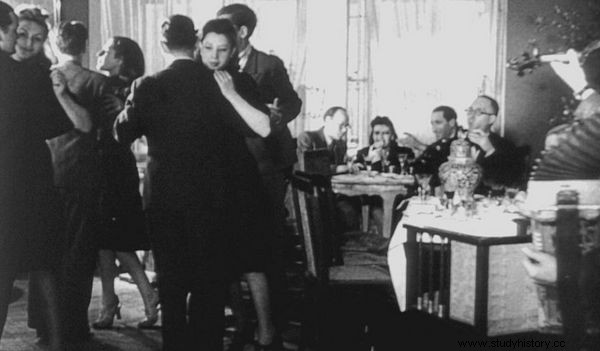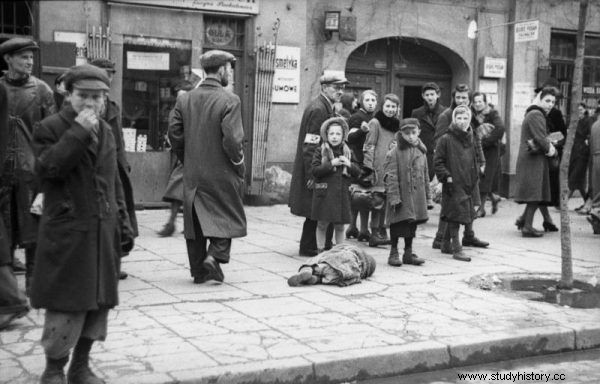Willy Wist, head of the film crew that came to occupied Warsaw in May 1942 to make a film in the ghetto. The peak of German hypocrisy.
Anyone who entered the ghetto walls for the first time could think of only one sentence - hell on earth. Dead bodies lying in the streets, starving and dead children, indescribable suffering. The perpetrators, however, decided to mock their victims and in the place where they organized their literal extermination - to shoot a material showing their prosperous and happy life.
The ghetto is like a graveyard
The Germans established the Warsaw ghetto in October 1940. It was the largest of its kind in Nazi-occupied Europe. In total, over 400,000 Jews were located there. At first, nothing foreshadowed the tragedy that was about to happen. It seemed that the Germans only wanted to regulate the division of the city. It was quickly realized that living in a separate ghetto would be a real nightmare.
Hunger, overcrowding in tenement houses, lack of hygiene, typhus epidemics and ubiquitous dirt. In such conditions, with no access to the outside world, the death rate hovered around 5,000 Jews a month . The only group of people who decided to help those locked behind the wall were Poles who delivered medicines and food to the ghetto. The West did not see or did not want to see German cruelty. In the face of constant contact with death, however, efforts were made to maintain at least some of the appearances of normal life. David Serrano Blanquer in his latest book, The Girl with a Suitcase, writes:
(...) despite these prison conditions, cramped conditions, epidemics and ubiquitous death, the inhabitants of the ghetto tried to survive. They organized cultural events, and artists and creators did not hesitate to show the tragedy that hit them. Libraries were opened, Oneg Shabbat was established [underground social organization - ed. B.B.], plays were staged, orchestras played, and secret youth organizations were established. Life had to go on, so people looked for ways to keep it going.

About 92,000 people died in the Warsaw ghetto in 1940-1942 due to hunger, cold and disease.
With time, the ghetto began to resemble a mass graveyard. It was in these circumstances that uniformed Nazis with cameras came here.
Movie propaganda
After the war, thousands of documents, including a lot of film material, were found in one of the wooded German bunkers. One of them was paying special attention. It contained four rolls of tape. There was only one inscription on the package - "Ghetto".
In this film recorded by the Germans, you can see the inhabitants of the ghetto, who happily shop at the market. In the streets you can see restaurants and smartly dressed women. However, all this contrasts with the poverty and death noticeable in the streets here.
One of the most eloquent shots is the dance of the ghetto jester Rubinstein, around which the crowd has gathered. At the same time, a man dies nearby. In another shot, poor and starving Jewish children stretch out their hands to dressed up waitresses - these, however, have no intention of sharing food with them. The scene was described by Abraham Lewin, an eyewitness to the events, a Warsaw teacher and later member of the institute documenting the fate of Jews in Poland under German occupation. According to his account, all the shots were staged. This is how he talked about one of them:
[the Germans] introduced the detainees of typical well-dressed Jews. They were seated at tables and ordered to serve the most expensive dishes and drinks, meat, fish, liqueur, white bread and other delicacies on the account of the commune. The Jews ate and the Germans filmed. For what purpose - it is easy to guess. These vile scenes lasted for several hours.
The tapes were supposed to deliver a simple message. Jews live in luxury but do not share with those members of the community who starve and die. The richest take part in banquets, where they devour themselves apart from their compatriots. Such scenes, showing the contrast of life in the ghetto, were the most numerous in German propaganda films. This is how David Serrano Blanquer describes this discrepancy in his latest book, The Girl with a Suitcase:
(...) the carefree inhabitants of the ghetto indifferently pass skinny corpses lying in the gutters; (...) sophisticated Jews throw great parties, while paupers beg for alms or die in the streets. This manipulation left the West unsure what to believe. It was only years later (...) that we realized, to our own horror, that the joyful scenes were staged, that they were filmed with the participation of actors, directed, and the set was prepared. All of this was to serve the powerful Nazi propaganda machine.
It should be noted, however, that the statement that there were no rich Jews in the ghetto at all would be a distortion. However, they constituted a small percentage of the entire Jewish population. Most often they were collaborators like Chaim Rumkowski (superior of the Jews in the Łódź ghetto), members of the Judenrat (the Jewish Council of Elders in the ghetto established by the Germans in 1939) or members of the Jewish police cooperating with the Germans . The average Jew communed with death, hunger and humiliation on a daily basis.

Wealthy, well-dressed Jews, who play in their homes and dine in restaurants, are insensitive to street beggars. This is how the Germans portrayed life in the ghetto to justify the extermination of a nation that does not deserve sympathy.
The main operator of the camera shooting the films from the Warsaw Ghetto was Willy Wist. After the war, he reported that he was given orders to film, among other things, faeces in the streets. The tapes also contain a shot in which a German soldier greets a Jewish child standing in front of a shop. On the other hand, you can also see scenes of circumcision and humiliating ritual baths. In public, however, in the edited recordings, were shown primarily joyful moments in the yard or impeccably decorated apartments with porcelain on shelves . The question remains:what was the main purpose behind these cynical tapes?
"Unfinished Movie"
The tapes were to be used to make a propaganda film that was later broadcast in German cinemas. The Minister of Propaganda of the Third Reich himself, Joseph Goebbels, was responsible for its execution. The message was obvious. After watching the material, the viewer was supposed to leave the room with the conviction that the Jews had no right to complain because the living conditions in the ghetto were great.
It was also intended to arouse the belief that the Jewish community itself is governed by the laws of injustice and exploitation of the poorest members, for whom the richest feel no sense of empathy or compassion . Is it not then necessary to deal with unfeeling and ruthless Jews? A similar goal was pursued by the film "Heimkehr", in which the Nazis portrayed Poles like animals hungry for German blood. This was, of course, to justify in the eyes of the citizens of the Third Reich Hitler's attack on Poland.

Scenes from the German film were sometimes repeated several times. The food for the "actors" was funded by the Germans themselves. Only to show the Jewish people as one of the most repulsive. The photo shows the inhabitants of the ghetto in 1941 (visible starvation victim).
Ultimately, however, the propaganda film from the Warsaw Ghetto was not finished. It is not known what was the reason for the discontinuation of assembly works. These were probably decisions taken at the highest levels of the Third Reich authorities. In 1942, the Nazis, chaired by Reinhard Heydrich, organized the Wannsee Conference, where they devised a plan to murder the entire European Jewish population by mass deportation eastward. In 1943, the Germans began to implement their criminal intentions. One of the first stages was the liquidation of the Warsaw ghetto.
Under these circumstances, the film by Willi Wist was no longer needed. Nevertheless, his tapes remain a mystery to many. The director, whose family died in the ghetto, Yael Hersonski, started their development. Based on the Wist tapes, she made a documentary entitled "Unfinished Movie". During the works, the woman showed footage shot by a German to one of the surviving Jewish women who had gone through the ordeal of living in the Warsaw ghetto. At the sight of the beautifully decorated apartment and the vase with flowers, she said only one sentence:" There you would not see any flowers in a vase, we would eat them ”.
